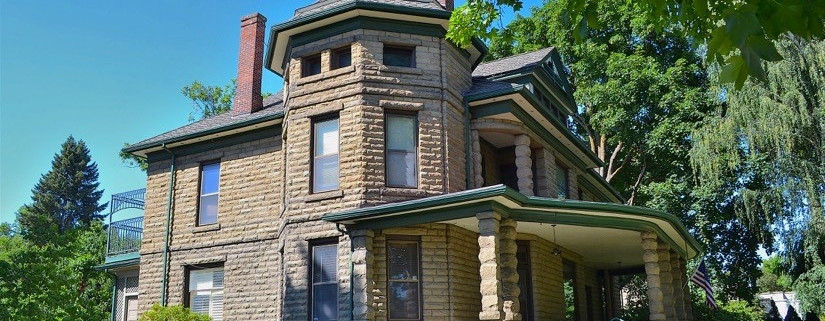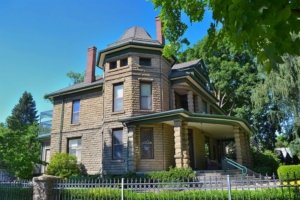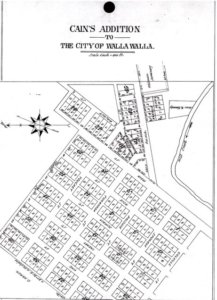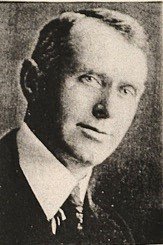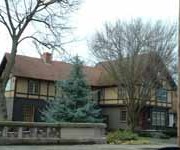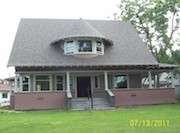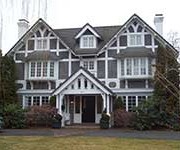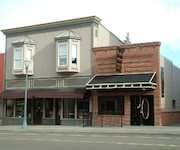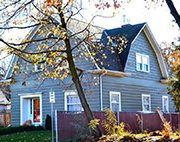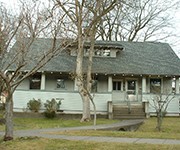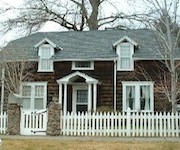History of 403 East Rose Street, Walla Walla, WA
Legal Description
Lots 6 and 7 in Block 14 of Cain’s Addition to the City of Walla Walla, according to the official plat thereof of record in the Office of the Auditor of Walla Walla County, Washington. Also a strip of land 4 feet in width adjoining said Lots 6 and 7 on the North Westerly side thereof and being a part of the vacated portion of the alley in said Block 14 of Cain’s Addition as vacated by the City of Walla Walla under Ordinance No. A-1317.
Title and Occupant History
Washington Territory was created in 1853. In 1854, the new territorial legislature created Walla Walla County, which stretched from the crest of the Cascade Mountains to the crest of the Rocky Mountains in the present states of Washington, Idaho and Montana. In 1855, Isaac Stevens, governor of Washington Territory, held a council on the banks of Mill Creek at the present site of Walla Walla with representatives of regional Indian tribes to purchase land from them. The Yakamas, Cayuses and Walla Wallas were dissatisfied with the treaties and the intrusion by whites into their lands before the treaties’ ratification, and war followed. Missionaries, former French-Canadian employees of the Hudson Bay Company trading post at Wallula, and soldiers at the military Fort Walla Walla were the primary European occupants of the area prior to 1859, when the treaties were finally ratified and the land was opened for settlement. The transfer of ownership occurred by virtue of a treaty signed on June 9, 1855 in Walla Walla and ratified on March 8, 1859 by President James Buchanan, in which all of the land in the Walla Walla area was acquired from the Cayuse and Walla Walla Indian tribes.
The town of Walla Walla was originally laid out by County Surveyor Hamet Hubbard Case in 1859, prior to its formal incorporation as a city in 1862, as a one-quarter mile square with its eastern side centered on the point where Main Street crossed Mill Creek (at roughly the point where it does now). Case’s plan was filed and recorded July 5, 1867 in Book A of Plats, Page 1. The City of Walla Walla received a Trustee Town site from the U. S. Government that consisted of 80 acres, issued on July 20, 1869 by the Vancouver, W. T. District Land Office.
9/10/1861, Patent, U. S. Government Land Office, Olympia, W. T. to Andrew J. Cain and Cornelius Kelly, 4 separate parcels, 160 total acres, located in Section 20, Township 7 North, Range 36 East, under the Script Warrant Act of 1855. This is the oldest U. S. Patent in Walla Walla. A. J. Cain surveyed this property in 1862; the survey was re-recorded May 11, 1865 following a disastrous fire that destroyed most of the county’s early records.
Cain began his career in the Walla Walla Valley at Fort Walla Walla in 1858, where he was employed as a quartermaster’s clerk. There he helped to prepare the treaty which ended the Yakama War. Shortly after, in 1859 or 1860, Cain moved to Walla Walla and began a legal practice. Cain became a wealthy businessman. In 1863, he established what became known as “Cain’s Addition” to the city limits: With a partner, Cain filed his 1861 patent on 160 acres of land northeast of downtown Walla Walla. The addition’s eight buildings doubled in the next year and grew rapidly thenceforth. These and other transactions described by newspapers suggest that Cain was a very wealthy man.
Cain’s Addition to the City of Walla Walla was filed on 1/17/1874 and recorded 1/31/1874.
2/14/1862, Deed, A. J. and Emma R. Cain, grantors; A. H. Reynolds, grantee, multiple parcels in Cain’s Addition to the City of Walla Walla, $1,000 at 36% interest. Almos Reynolds arrived in Walla Walla in 1859, entering the money lending business and eventually opening a bank. He resided at 110 North Second.
11/18/1867, Sheriff’s Deed, A. Seitel, Sheriff of Walla Walla County, W. T. to D. S. Baker, to recover $7,320.56 from A. J. and E. R. Cain, consideration $2,800. Dr. Dorsey Singh Baker could arguably be described as a key to building Walla Walla, beginning in 1859. A physician by training, he did not practice medicine in Walla Walla, but became involved in the cattle business, opened a mercantile with John F. Boyer, his brother-in-law, and built a railroad from Wallula to Walla Walla. So trusted was Baker by miners returning from Idaho that they would leave their gold with him. He and Boyer eventually opened Baker Boyer National Bank.
10/20/1871, Deed, Andrew J. and Emma R. Cain, grantors; Dorsey S. Baker, grantee, Lots 6 and 7, Block 14 and other parcels, $1.
6/11/1872, Deed, Dorsey S. Baker, grantor; Isaac N. Reed, grantee, Block 14 and other parcels in Cain’s Addition. Isaac N. Reed was born in Delaware County, Ohio in 1837. He married Cynthia Jane Hungate (b. 1842 in Illinois) in 1863. The Reeds had two boys, Calvin (b. 1865) and Howard (b. 1878).
6/11/1872, Warranty Deed Against Grantors, Dorsey S. and Elizabeth H. Baker, grantors; I. N. Reed, grantee, Block 14 and numerous other lots and/or blocks all in Cain’s Addition, $1,285.
5/20/1876, Warranty Deed Against Grantors, Isaac N. and Cynthia Reed, grantors; Joseph A. Hungate, Lots 6 and 7, Block 14 of Cain’s Addition, $270. This transfer represents the first separation of Lots 6 and 7 from all other parcels of land.
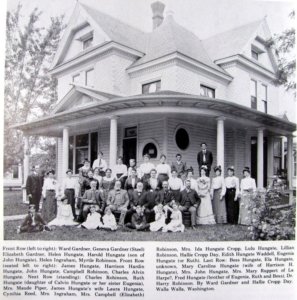
The residence of Campbell Robinson at 429 East Sumach Street (extant). Ida Hungate Cropp is standing in the third row, ninth from the left, and numerous other members of the Hungate family are in the photo. (Robinson’s relation to the Hungate family is not known, but can be established by the fact that he had a son named Harry Hungate Robinson who was a student at Whitman College at the time of this photo, ca. 1904. Photo courtesy of Joe Drazan.
12/17/1878, Warranty Deed, J. A. and Elizabeth Hungate, grantors; Harrison H. Hungate, grantee, Lots 6 and 7, Block 14, $1,000. Walla Walla pioneer Harrison Harden Hungate, was born in Illinois around 1836, and resided in the same county in that state where Isaac N. Reed and Cynthia Jane Hungate were married. Although their relationship could not be determined for certain, they were not siblings. H. H. Hungate settled in Walla Walla, growing prosperous as a grain grower and stockman. He built an elaborate Victorian house at 202 North 2nd (demolished). He also financed construction of the H. H. Hungate Building on East Main Street just west of Palouse Street.
12/6/1879, Warranty Deed, Harrison H. and Mary C. Hungate, grantors; Ida J. Hungate, grantee, $1 “and further consideration of love and affection we bear our daughter.”
3/30/1896, Quit Claim Deed, John F. and Sarah E. Boyer, grantors; Dorsey S. Baker, grantee, having acquired a portion of Cain’s Addition, the Boyers released their one-third ownership to Dorsey Baker, $1.
5/6/1924, Quit Claim Deed, J. F. Cropp, grantor; Hallie Cropp Day, grantee, Lots 6 and 7, Block 14 of Cain’s Addition and Lots 3 through 12, Block 1, Eidlewilde Addition, $1. Hallie Cropp Day was a daughter of Dr. Joseph and Ida Cropp.
12/16/1936, Warranty Deed, Hallie C. and George B. Day, grantors; Fred W. and Josephine Falconer, grantees, Lots 6 and 7, $10 and other valuable considerations. George B. Day, Hallie Cropp Day’s husband, was Postmaster of Walla Walla. The Days resided in the Marcus Whitman Hotel. Fred Falconer was a farmer who maintained a city residence at 403 East Rose Street.
10/7/1940, Warranty Deed, Fred W. and Josephine Falconer, grantors; M. L. and Elva O. Myers, grantees, Lots 6 and 7, $10 and other valuable considerations subject to a mortgage in favor of George Day in the principal sum of $1,000. No city directory listing for the Myerses could be located. The house was rented in 1941 to George Thompson Massage.
10/4/1943, Warranty Deed, M. L. Myers, grantor; Elva O. Myers, grantee, $1 and other valuable considerations.
2/21/1945, Warranty Deed, M. L. and Elva O. Myers, grantors; A. J. and Cora W. Knollin, grantees, $10 and other valuable considerations. No occupation for A. J. Knollin was noted, but the Knollins did reside at 403 East Rose Street.
7/8/1950, Warranty Deed, Cora Knollin, a widow, Mabel K. Gilpatrick, James C. Knollin, Loyal C. Knollin and Mabel K. Gilpatrick as Executrix under the Last Will and Testament of Albert J. Knollin, deceased, grantors; Laura N. LePage, a widow, grantee, $14,000. Laura LePage, widow of George, was employed at the time as a waitress at the Marcus Whitman Hotel Coffee Shop. Her address was listed as 403 East Rose, Apt. 8, so she may well have rented out rooms in the house.
6/3/1983, Statutory Warranty Deed, Laura N. LePage, as her separate property, grantor; Martha Ann Warren, a single person, $10 and other valuable considerations. Martha Warren, aka Marty Warren, owned Red House Antiques and lived at 403 East Rose Street.
4/9/1993, Special Power of Attorney, Martha Ann Warren Thomas appointed Myrna Bowen “… to bargain, sell, contract to convey or convey … Lots 6 and 7, Block 14, Cain’s Addition.”
4/9/1993, Statutory Warranty Deed, Martha Ann Warren, as her separate estate, grantor; Dale F. and Antonia A. Ross, grantees, $10 and other valuable considerations. Dale Ross was owner of Ross Family Realtors.
9/15/1995, Statutory Warranty Deed, Dale F. and Antonia A. Ross, grantors; Joanne Price and Stephen J. Huntington, grantees, $215,000. Price and Huntington, husband and wife, resided at 403 East Rose Street, which also housed Joanne Price’s audiology business for a number of years.
12/22/2008, Personal Representative Deed, Joanne Price, personal representative of the estate of Stephen J. Huntington, deceased, to clear title, quit claims to Joanne Price Parcel 36-07-20-57-1406.
4/26/2019, Statutory Warranty Deed, Joanne Price, grantor; Brian Lawenda, grantee.
Construction of Building
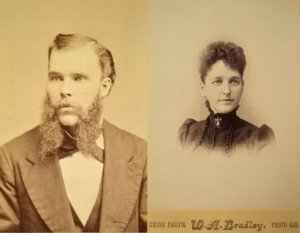
Dr. James F. and Ida Hungate Cropp, probably around the time of their marriage. Whitman Archives photos.
James Francis Cropp was born in Virginia April 16, 1854. With his parents, he arrived in Washington Territory in 1872, receiving his early education in a log cabin and working in the hay fields in the Dry Creek area. He began teaching in Walla Walla in 1876, but, with a long-held desire to become a physician, that year he walked to Portland. From Portland he caught a steamer to San Francisco and entered the University of California to study medicine. Upon completing his education at UC, he both walked to and worked freight trains until he reached Philadelphia, where he entered Jefferson Medical College, from which he graduated in 1878. Returning to Walla Walla, he worked as physician for the then-Territorial Penitentiary and the I.O.O.F. Home. He married Ida Hungate, daughter of H. H. and Mary C. Hungate, in 1879. They had two children, Harry Hungate Cropp, 1880-1883, and Hallie Cropp Day, 1884-1983. In 1890, Dr. Cropp established Walla Walla Hospital, which later became Walla Walla General Hospital on Bonsella Street. He maintained his office for a number of years over Day’s Drug Store in the beautifully restored Reynolds-Day Building on East Main Street. Dr. Cropp was preceded in death by his wife, Ida, in 1922.
Dr. Cropp remarried a year after Ida’s death; the 1923 city directory includes a second wife, Gertrude Cropp, who was over 40 years younger than her new husband. They resided at 4 Park Place. By 1925, the Cropps had relocated to Clinton Court. Two years later, however, they were residing at 227 West Oak. This is a small hipped-roof working man’s cottage that does not appear befitting of Dr. Cropp’s status in Walla Walla. Following his death in 1933, Gertrude, continued in residence at the Oak Street address. She lived to the age of 101, dying in 1998. That year, 1933, George B. Day and Hallie Cropp Day moved to 403 East Rose Street, where they continued to live until early 1937, when they moved to the Marcus Whitman Hotel, having sold the Rose Street house to Fred and Josephine Falconer in December 1936.
The Walla Walla County Assessor lists a build date of 1900 for 403 East Rose Street, as does author Penny Andres in her first volume on Walla Walla’s historic houses. Assessor’s build dates are often estimates, thus are frequently inaccurate.
The list of deeds for this property on file at Pioneer/Columbia Title and at the Auditor’s Office show a gap between 1896 and 1924. A search of both the direct and reverse Indexes during these years revealed no sale of these lots to Dr. Cropp (the male spouse usually being the primary person listed as grantee).
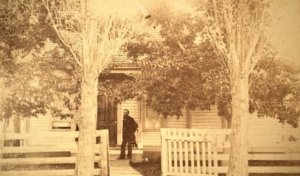
Dr. Cropp in front of the first house he built on the corner of East Rose and Tukanon Streets. Whitman Archives photo.
Dr. Cropp and Ida Hungate were married in 1879. The warranty deed of 12/6/1879 reflects a transfer of Lots 6 and 7 to Ida Hungate from her parents, H. H. and Mary Hungate. It can thus be conjectured with reasonable validity that these lots were a wedding gift to their daughter and son-in-law from Ida’s parents. The first listing in a city directory for Dr. Cropp was in the 1880 edition, showing his residence being at “Rose and Tukanon.” (Wives were not included in directory listings at the time.) In fact, Dr. and Mrs. Cropp resided in a smaller house on this property at the time, that can presumably be dated to 1880 or 81. The earliest Sanborn Fire Map that includes East Rose Street beyond Tukanon Street was published in September 1890 and shows the smaller Cropp house. The Tenino sandstone Cropp house is not included on a Sanborn Fire Map until the 1905 edition, there having been only one update (1894) between the 1890 and 1905 editions.
City of Walla Walla building permits were preserved only as far back as September 1907. A search of the Index for old microfilmed Walla Walla newspapers did not reveal a mention of the second and current house on this property. However, Whitman Archives possesses a folder on the prolific early-day contractor, Alexander Taylor that includes a comprehensive listing of every building that he either built or worked on, not only in Walla Walla, but also throughout the Pacific Northwest, that was compiled in 2002 by his grandson, Roger Bordeaux Taylor of Fresno, California. Alexander Taylor, born in Scotland in 1870, was the oldest of seven children. The family left Scotland for the United States in 1882, settling first in Milwaukee, where they lived in a German-American community. Alexander’s early education was at Milwaukee’s German-American Academy. In 1882, they relocated to Portland, where his father became a stonecutter, teaching Alexander the trade. As an adult, it was the contract for the Cropp house that first brought Alexander to Walla Walla. Seeing opportunity here, he moved his family to Walla Walla. Despite the fact he was of Scottish descent, probably as the result of having spent so much time in German-American communities while growing up, Taylor befriended and hired German immigrants to work for him as he began his trade in Walla Walla. And, he befriended Walla Walla’s most prominent architect of the time, German-born Henry Osterman. Although there is no concrete proof of this, Taylor’s grandson, Roger Bordeaux Taylor believes that Osterman was in fact the likely architect of the Cropp house.
In 1915, Taylor constructed the Tudor Arms Apartments in Portland Oregon, designed by the German-American Portland architect Carl Linde, who had designed Walla Walla’s grand Elk’s Temple (1912-13) at Fourth and Alder. The building is on the National Register of Historic Places.
Taylor’s first inclusion in a Walla Walla city directory was in 1901, when he was listed as a brick mason, residing at 527 West Alder Street. In 1902, he was listed as a mason, with residence at 410 Chase Avenue. In 1904, he was again listed as a brick mason, at 52 Clinton Street. In the 1905 edition, he was listed as a brick and stone contractor, and by the following year he had formed a partnership with his brother-in-law, Joseph D. Wassell, dba Taylor & Wassell.
It is apparent from the four pages of buildings that Taylor and Taylor & Wassell either constructed or worked on, that he/they must have been extremely talented in working with brick, stone and/or concrete. Their work included masonry structures exclusively. Just a few of the prominent local buildings they were involved with include Green Park School, the Denny Building, the addition to Sharpstein School, the American (later named Liberty) Theatre, the Telephone Building, the Parish House for First Congregational Church, the George Struthers residence, the Stephen B. L. and Mary Penrose residence (Penrose House), the A. M. Jensen Department Store (now Macy’s), Borleske Stadium, and both Lyman House and Prentiss Hall on the Whitman campus. It is also remarkable that Taylor’s grandson’s notes show that this trade was carried on for generations in both the Taylor and Wassell families. Alexander Taylor died in 1945 in Walla Walla and is buried in Portland.
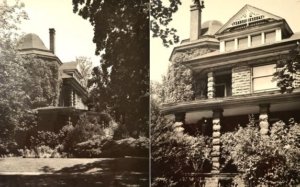
Two artistic photographs of the Cropp residence by the Swiss-born Seattle architecture photographer Werner Leggenhager (1899-1988), probably taken in 1968. Whitman Archives.
According to Taylor’s grandson’s listing of works constructed by Alexander Taylor, the Cropp house was Taylor’s first commission in Walla Walla, constructed in 1899. Whether it was entirely completed in 1899 or begun that year and completed in 1900 Roger Taylor could not say. In her book, the late Penny Andres describes it as “Walla Walla’s finest example of the Richardsonian Romanesque style…” Presumably, she based this on the primary construction material, Tenino sandstone. However, despite the unusual use of sandstone, the style of the Cropp house is far more redolent of Queen Anne architecture, with its irregular massing, a wrap-around front porch, a recessed porch on the second level above the entry, the octagonal tower with its subtle S-curved roof, and the Eastlake-inspired jigsaw-cut and spindle embellishments at the peak of the front third floor gable. (Eastlake detail is carried out in the interior of the house.)
Taylor’s grandson also stated that Alexander Taylor generally worked as a subcontractor. His responsibility concerning 403 East Rose Street included all of the Tenino sandstone and brickwork. The jigsaw-cut and lathe-turned ornament at the front dormer and the elaborate interior woodwork would have been completed by a different contractor.
Resources
- Pioneer/Columbia Title
- Whitman Archives
- Sanborn Fire Maps, 1894 and 1905
- Lyman, Prof. W. D., History of Old Walla Walla County, Embracing Walla Walla, Columbia, Garfield and Asotin Counties, Vol. 2, S. J. Clarke Publishing Company, Chicago, 1918
- Gregg, Will, A Man and His Pipe, Whitman Wire, March 1, 2014
- rootsweb.com
- Taylor, Roger Bordeaux, The Building Legacy of Alexander Taylor in the Pacific Northwest, 1899-1944, 2002, Fresno, CA
- Telephone conversation with Roger Bordeaux Taylor, 7/14/2019
- Susan Monahan, Historian
- Walla Walla Union, 5/13/1911
- Mountain View Cemetery records
- Walla Walla County Clerk
- Walla Walla County Auditor
- Andres, Penny, Walla Walla: Her Historic Homes, Vol. 1, Walla Walla, 1991
- City Directories, various years
- findagrave.com

